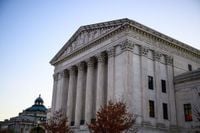As the US Supreme Court weighs the legality of President Donald Trump’s sweeping tariffs, Americans are watching closely—and feeling the pinch in their wallets. The tariffs, imposed earlier this year under the International Emergency Economic Powers Act (IEEPA), have not only sparked legal debate but also ignited a fervor on Wall Street and Main Street alike. With over $100 billion in import taxes paid by US companies since the tariffs’ inception, the stakes could hardly be higher.
According to a recent Economist / YouGov poll conducted between November 15 and 17, 2025, a clear majority of Americans favor increasing trade with foreign countries (42%) rather than decreasing it (11%), while 27% prefer to keep trade at its current level. The poll also reveals that 55% of Americans believe foreign trade makes the average American better off, compared to just 15% who think it makes them worse off and 11% who see no effect at all. When it comes to tariffs specifically, only 13% want to see them increased, while 47% prefer tariffs be decreased and 24% want them kept the same.
Perhaps most telling: nearly three-quarters (73%) of Americans say they’ve paid higher prices because of Trump’s tariffs, with 40% reporting prices increased significantly and another 33% noting a slight uptick. This sentiment cuts across party lines—majorities of Democrats (92%), Independents (72%), and even Republicans (56%) acknowledge the tariffs have led to higher costs at the checkout line.
Behind the scenes, Wall Street is making some bold bets. As reported by Bloomberg, financial firms are purchasing rights to refunds on tariffs paid by US importers, wagering that the Supreme Court will ultimately strike down the levies and pave the way for companies to be reimbursed. The legal uncertainty has created a hot new trade, with potential windfalls for those who correctly anticipate the Court’s decision.
At the heart of the legal battle are two consolidated cases: Trump v. V.O.S. Selections and Learning Resources Inc. v. Trump. The Supreme Court heard oral arguments on November 5, 2025, in an unusually lengthy session that lasted nearly three hours. The crux of the dispute is whether the IEEPA grants the president authority to impose tariffs as a tool to address national security, foreign policy, or economic emergencies. The law, dating back to 1977, was invoked by Trump through five executive orders beginning in February of this year.
During the oral arguments, skepticism from the justices was palpable. According to Tax Notes managing legal reporter Caitlin Mullaney, who attended the session, “It definitely felt like the wind was blowing against the favor of the government, and that hasn’t changed following the arguments. I believe, actually, the last I checked, there was less than a 25 percent chance of the Supreme Court ruling in favor of the tariffs.”
The government’s main argument, presented by US Solicitor General D. John Sauer, was that the phrase ‘regulate importation’ in the IEEPA plainly includes tariffs, which have long been a traditional method of regulating imports. Sauer also contended that the major questions doctrine—a legal principle requiring clear congressional authorization for matters of vast economic and political significance—does not apply here, since Congress would naturally confer major powers on the president to handle foreign emergencies.
But the justices weren’t easily convinced. Chief Justice John Roberts pressed Sauer on why the major questions doctrine shouldn’t apply, pointing out that the authority being claimed was “major” and that IEEPA had never before been used to justify tariffs. Justice Neil Gorsuch echoed similar concerns, questioning whether Congress could simply delegate all its power to regulate commerce, including tariffs, to the president. “Isn’t that the logic of your view though?” Gorsuch asked pointedly.
On the other side, Neal Katyal, representing private businesses challenging the tariffs, argued that tariffs are essentially taxes paid by American people and businesses—a power the Constitution reserves for Congress unless explicitly delegated. Katyal stated, “Tariffs are a tax. They are paid by the American people, they are paid by American businesses, and that power has not been delegated to the president by Congress under IEEPA.” He emphasized that if Congress had intended to include tariffs in the statute, it would have said so directly.
The debate also delved into historical and linguistic nuances, with justices and attorneys parsing the difference between regulating imports through quotas, embargoes, licenses, or tariffs. Justice Brett Kavanaugh challenged Katyal’s argument, noting that in previous cases, the Court had allowed presidential regulation of imports without the statute explicitly mentioning tariffs. Still, Katyal maintained that tariffs are unique due to their revenue-raising function—a distinction rooted in the nation’s founding, when tariffs were the chief source of government revenue and a major point of contention (think Boston Tea Party, not Boston Embargo Party, as Katyal quipped).
Further complicating matters, the Oregon Solicitor General, Benjamin Gutman, representing state plaintiffs, argued that while the president could theoretically shut down trade with another nation under IEEPA, he could not impose even a minimal tariff because of the constitutional concerns around revenue-raising powers. Justice Kavanaugh found this logic odd, calling it “an odd doughnut hole in the statute,” to which Gutman replied, “It’s not a doughnut hole, it’s a different kind of pastry.”
Beyond the courtroom, the public’s expectations are mixed. The YouGov poll found that more Americans expect the Supreme Court to allow the tariffs to stand (42%) than to strike them down (25%), even though a larger share would prefer the Court to strike down the tariffs (49% versus 33%). Among those wanting the tariffs struck down, only 38% expect that outcome, while 35% believe the tariffs will stand regardless of their preference. Conversely, two-thirds (67%) of those who want the tariffs to stand are confident they will, with only 14% expecting the Court to overturn them.
Meanwhile, the broader economic impact is undeniable. With over $100 billion in import taxes paid since the tariffs’ rollout, American companies and consumers alike are feeling the effects. The possibility of refunds has led to a speculative frenzy among financial firms, who are buying up rights to potential reimbursements in anticipation of a Supreme Court decision. The courts’ skepticism about the president’s authority under IEEPA, coupled with the justices’ pointed questioning, has only fueled the uncertainty—and the stakes.
As the nation waits for the Supreme Court’s expedited decision, expected before the end of the year, the outcome could reshape not only tariff policy but also the balance of power between Congress and the president in matters of trade and national security. For now, Americans remain divided in their expectations but united in their desire for relief from rising prices—a sentiment echoed across political lines and economic sectors.
Whatever the Court decides, the ripple effects will be felt far beyond the marble halls of justice, touching every American who shops, works, or invests in a global economy.

